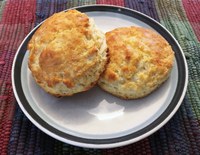Prairie Fare: Bake Some Comforting Biscuits This Winter
(Click an image below to view a high-resolution image that can be downloaded)
By Julie Garden-Robinson, Food and Nutrition Specialist
NDSU Extension
All restaurants and stores were closed due to the blizzard, and I was in search of comfort food for brunch.
Biscuits and scrambled eggs with the leftover holiday ham sounded tasty to me.
“Do we have any canned biscuits?” I asked as I searched the fridge.
“I don’t think so,” my husband replied. “Why don’t you be a pioneer woman and make them from scratch?”
The roads to the nearby grocery store were undriveable, so making some hearty homemade biscuits sounded like a good plan to me.
I picked up my phone and looked for a recipe online. I found one I had never tried.
I gathered all the ingredients and quickly began mixing. When my husband saw me dipping the small chunks of butter out of the flour, he decided to tease me a little.
“Ha. Ha. You mixed the ingredients in the wrong order,” he commented.
Why did he have to see that?
I was working too fast. I added the missing ingredient to the flour, blended it and added the butter chunks. Then I handed my husband the pastry blender.
“Have you seen the TV show ‘Dateline’?” I asked with a smirk on my face.
He knew where I was going with my counter-teasing.
“Yes, I suppose this would be an episode where the wife sends her husband out to plow snow, and he disappears,” he replied.
“Maybe that’s what I was thinking,” I noted. “The plowing can wait because I need a little help. You can blend the butter into the flour.”
Our collaborative cooking effort yielded some really tasty biscuits. We have a lot of background in the food science area. My husband was a flour milling superintendent for more than 20 years at a couple of large food companies, where the mills produced a million pounds of flour daily. I have a doctorate in cereal chemistry.
Winter is a prime time to explore some culinary challenges. Making yeast bread and quick breads is a lesson in food science and fills your home with a delicious aroma.
Biscuits, muffins, cakes and cookies typically rely on baking powder and/or baking soda to rise in the oven. These leavening agents produce carbon dioxide in the right conditions and allow the baked good to rise. Baking powder includes an acid such as tartaric acid, along with baking soda (sodium bicarbonate).
Careful measuring and proper mixing are keys to baking success. Biscuits should be tender, light and airy with layers that separate. When you cut in the butter, you are separating the gluten proteins. Overkneading the dough can result in flat, tough biscuits when the gluten proteins are overdeveloped.
We used all-purpose flour in the recipe. It is used widely in baked goods, including biscuits, cookies and muffins. It is a blend of “hard” and “soft” wheat grains to reach the correct protein level for baking success.
Bread flour is made from hard wheat (such as hard red spring wheat grown widely in North Dakota) or another “hard” flour. It typically is used to make yeast bread. The higher protein content in bread flour helps create a strong structure during the mixing process. Yeast ferments the flour starch and/or sugar, producing carbon dioxide.
Cake flour is made from softer wheat varieties and produces a finer, more delicate-textured baked product. If you need 1 cup of cake flour, remove 2 tablespoons of all-purpose flour from the cup and add 2 tablespoons of corn starch.
Self-rising flour already has salt and the leavening agent added to it. Be sure to use a recipe that was developed for this flour product. Usually the company prints recipes on the flour bag.
Whole-wheat flour includes all parts of the grain, including the bran and germ. It is higher in fat and, therefore, can become rancid during storage. Store whole-wheat flour in a cool, dark place. If you won’t use up the whole-wheat flour within a couple of months, store the flour package in your refrigerator or freezer in a resealable freezer bag.
The homemade biscuits were much tastier than biscuits from a can. My thanks goes to “momontimeout.com” for posting this recipe for me to adapt slightly. My little blunder during mixing had no effect, by the way. The hot biscuits were delicious with a drizzle of honey.
Try baking or cooking something new this winter. See https://www.ag.ndsu.edu/food for a wide variety of nutrition, food safety and health resources to explore.
Homemade Biscuits
3 c. all-purpose flour
3 Tbsp. sugar
1/2 tsp. salt
4 tsp. baking powder
1/2 tsp. cream of tartar
3/4 c. cold butter
1 egg
1 c. cold milk
Note: I reduced the sugar to 2 tablespoons, and used unsalted butter and low-fat milk.
Preheat oven to 450 F. Line a baking sheet with parchment paper or lightly grease. Cut the cold butter into small pieces and put in refrigerator until ready to incorporate. Combine the dry ingredients in a large bowl. Mix egg and milk in a cup with a whisk. Add butter to dry ingredients and cut the butter into the mixture using a pastry blender until the particles are about the size of peas. Add the egg-milk mixture to the dough. Mix just until combined. Place the dough onto a floured surface and knead about 10 times. Pat the dough into a circle about 3/4 inch thick, then cut with a floured round biscuit cutter or glass. Pat out remaining dough and cut. Bake for about 12 minutes or until golden brown.
Makes 12 biscuits. Each biscuit has 240 calories, 12 grams (g) fat, 4 g protein, 27 g carbohydrate, 1 g fiber and 280 milligrams sodium.
(Julie Garden-Robinson, Ph.D., R.D., L.R.D., is a North Dakota State University Extension food and nutrition specialist and professor in the Department of Health, Nutrition and Exercise Sciences. Follow her on Twitter @jgardenrobinson)
NDSU Agriculture Communication - Jan. 9, 2020
| Source: | Julie Garden-Robinson, 701-231-7187, julie.garden-robinson@ndsu.edu |
|---|---|
| Editor: | Ellen Crawford, 701-231-5391, ellen.crawford@ndsu.edu |



